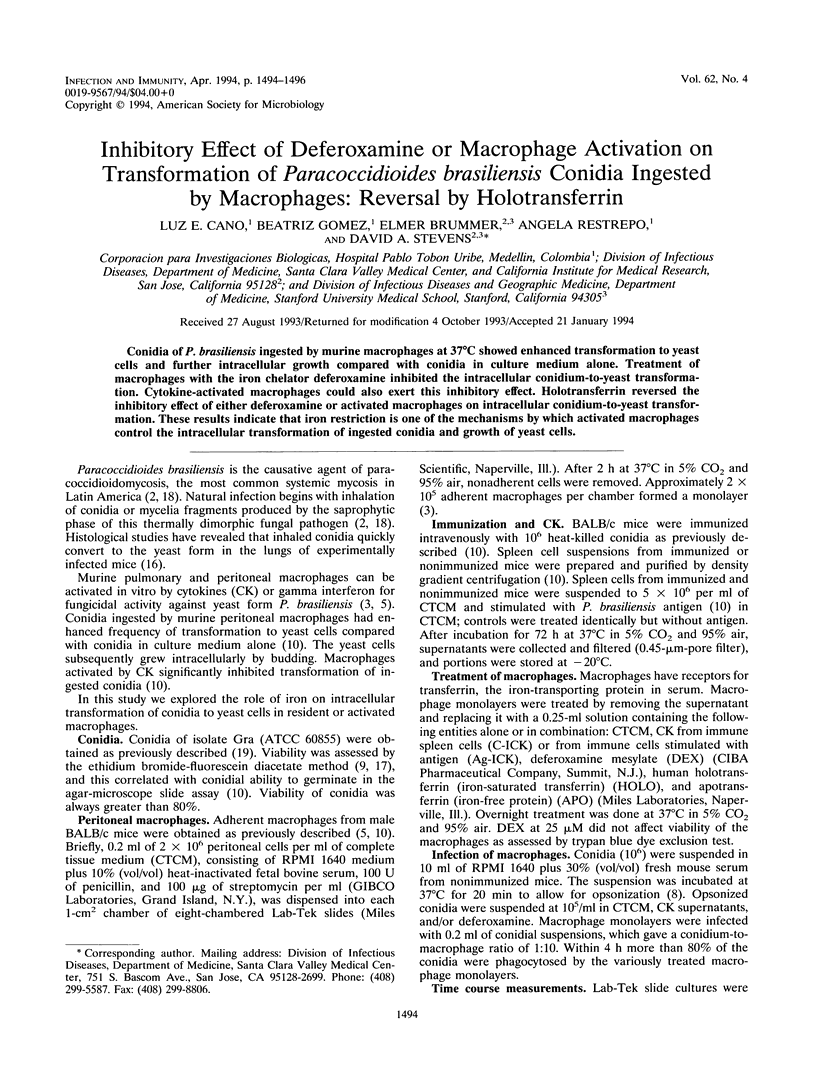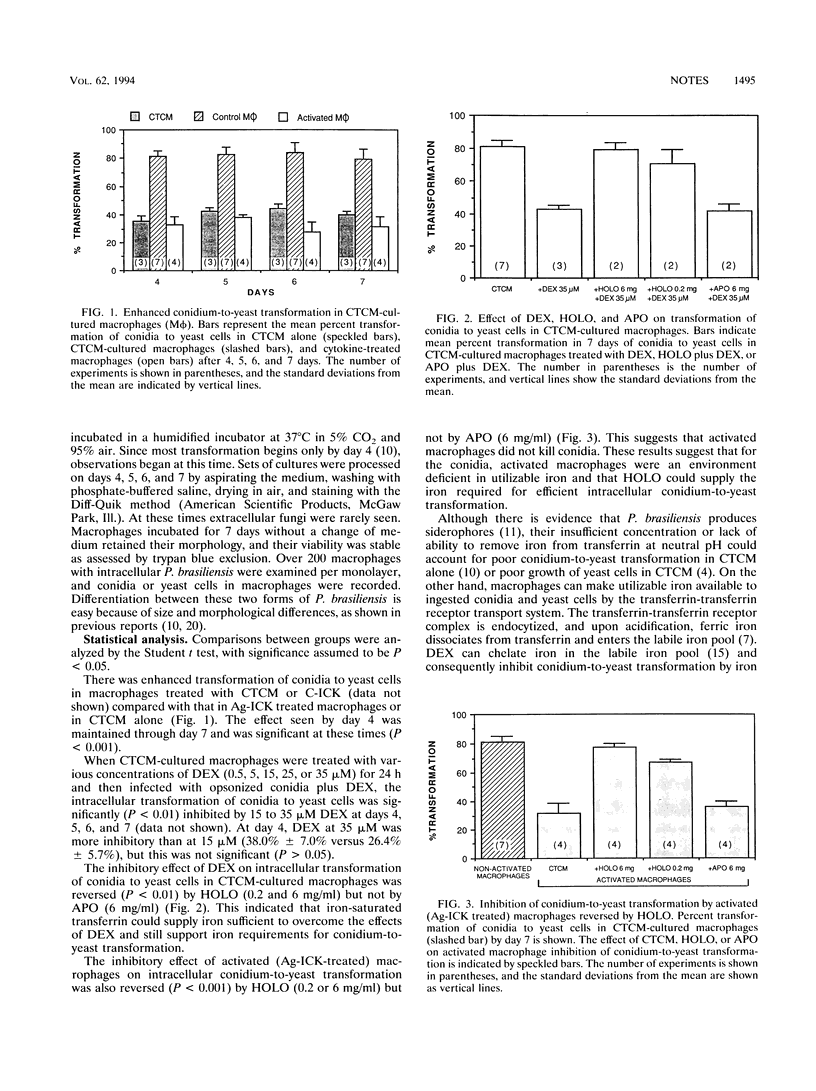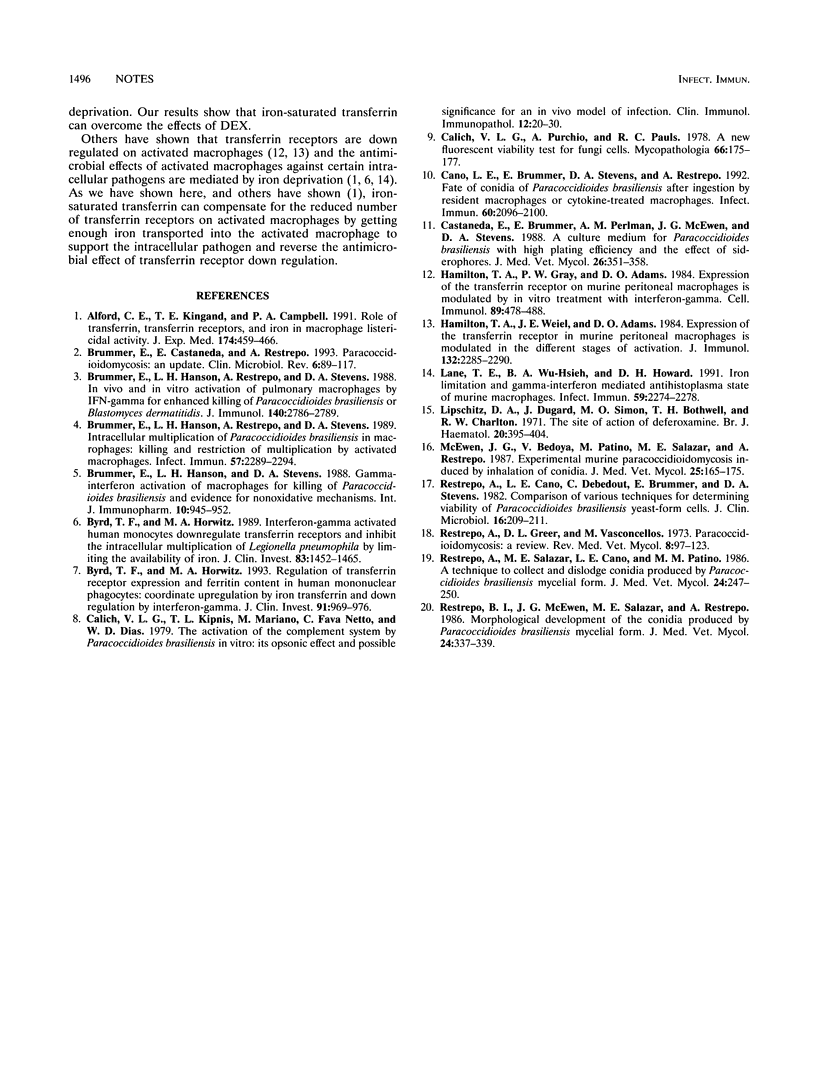Abstract
Conidia of P. brasiliensis ingested by murine macrophages at 37 degrees C showed enhanced transformation to yeast cells and further intracellular growth compared with conidia in culture medium alone. Treatment of macrophages with the iron chelator deferoxamine inhibited the intracellular conidium-to-yeast transformation. Cytokine-activated macrophages could also exert this inhibitory effect. Holotransferrin reversed the inhibitory effect of either deferoxamine or activated macrophages on intracellular conidium-to-yeast transformation. These results indicate that iron restriction is one of the mechanisms by which activated macrophages control the intracellular transformation of ingested conidia and growth of yeast cells.
Full text
PDF


Selected References
These references are in PubMed. This may not be the complete list of references from this article.
- Alford C. E., King T. E., Jr, Campbell P. A. Role of transferrin, transferrin receptors, and iron in macrophage listericidal activity. J Exp Med. 1991 Aug 1;174(2):459–466. doi: 10.1084/jem.174.2.459. [DOI] [PMC free article] [PubMed] [Google Scholar]
- Brummer E., Castaneda E., Restrepo A. Paracoccidioidomycosis: an update. Clin Microbiol Rev. 1993 Apr;6(2):89–117. doi: 10.1128/cmr.6.2.89. [DOI] [PMC free article] [PubMed] [Google Scholar]
- Brummer E., Hanson L. H., Restrepo A., Stevens D. A. In vivo and in vitro activation of pulmonary macrophages by IFN-gamma for enhanced killing of Paracoccidioides brasiliensis or Blastomyces dermatitidis. J Immunol. 1988 Apr 15;140(8):2786–2789. [PubMed] [Google Scholar]
- Brummer E., Hanson L. H., Restrepo A., Stevens D. A. Intracellular multiplication of Paracoccidioides brasiliensis in macrophages: killing and restriction of multiplication by activated macrophages. Infect Immun. 1989 Aug;57(8):2289–2294. doi: 10.1128/iai.57.8.2289-2294.1989. [DOI] [PMC free article] [PubMed] [Google Scholar]
- Brummer E., Hanson L. H., Stevens D. A. Gamma-interferon activation of macrophages for killing of Paracoccidioides brasiliensis and evidence for nonoxidative mechanisms. Int J Immunopharmacol. 1988;10(8):945–952. doi: 10.1016/0192-0561(88)90041-0. [DOI] [PubMed] [Google Scholar]
- Byrd T. F., Horwitz M. A. Interferon gamma-activated human monocytes downregulate transferrin receptors and inhibit the intracellular multiplication of Legionella pneumophila by limiting the availability of iron. J Clin Invest. 1989 May;83(5):1457–1465. doi: 10.1172/JCI114038. [DOI] [PMC free article] [PubMed] [Google Scholar]
- Byrd T. F., Horwitz M. A. Regulation of transferrin receptor expression and ferritin content in human mononuclear phagocytes. Coordinate upregulation by iron transferrin and downregulation by interferon gamma. J Clin Invest. 1993 Mar;91(3):969–976. doi: 10.1172/JCI116318. [DOI] [PMC free article] [PubMed] [Google Scholar]
- Calich V. L., Purchio A., Paula C. R. A new fluorescent viability test for fungi cells. Mycopathologia. 1979 Feb 28;66(3):175–177. doi: 10.1007/BF00683967. [DOI] [PubMed] [Google Scholar]
- Cano L. E., Brummer E., Stevens D. A., Restrepo A. Fate of conidia of Paracoccidioides brasiliensis after ingestion by resident macrophages or cytokine-treated macrophages. Infect Immun. 1992 May;60(5):2096–2100. doi: 10.1128/iai.60.5.2096-2100.1992. [DOI] [PMC free article] [PubMed] [Google Scholar]
- Castaneda E., Brummer E., Perlman A. M., McEwen J. G., Stevens D. A. A culture medium for Paracoccidioides brasiliensis with high plating efficiency, and the effect of siderophores. J Med Vet Mycol. 1988;26(6):351–358. [PubMed] [Google Scholar]
- Hamilton T. A., Gray P. W., Adams D. O. Expression of the transferrin receptor on murine peritoneal macrophages is modulated by in vitro treatment with interferon gamma. Cell Immunol. 1984 Dec;89(2):478–488. doi: 10.1016/0008-8749(84)90348-4. [DOI] [PubMed] [Google Scholar]
- Hamilton T. A., Weiel J. E., Adams D. O. Expression of the transferrin receptor in murine peritoneal macrophages is modulated in the different stages of activation. J Immunol. 1984 May;132(5):2285–2290. [PubMed] [Google Scholar]
- Lane T. E., Wu-Hsieh B. A., Howard D. H. Iron limitation and the gamma interferon-mediated antihistoplasma state of murine macrophages. Infect Immun. 1991 Jul;59(7):2274–2278. doi: 10.1128/iai.59.7.2274-2278.1991. [DOI] [PMC free article] [PubMed] [Google Scholar]
- Lipschitz D. A., Dugard J., Simon M. O., Bothwell T. H., Charlton R. W. The site of action of desferrioxamine. Br J Haematol. 1971 Apr;20(4):395–404. doi: 10.1111/j.1365-2141.1971.tb07051.x. [DOI] [PubMed] [Google Scholar]
- McEwen J. G., Bedoya V., Patiño M. M., Salazar M. E., Restrepo A. Experimental murine paracoccidiodomycosis induced by the inhalation of conidia. J Med Vet Mycol. 1987 Jun;25(3):165–175. doi: 10.1080/02681218780000231. [DOI] [PubMed] [Google Scholar]
- Restrepo A., Cano L. E., de Bedout C., Brummer E., Stevens D. A. Comparison of various techniques for determining viability of Paracoccidioides brasiliensis yeast-form cells. J Clin Microbiol. 1982 Jul;16(1):209–211. doi: 10.1128/jcm.16.1.209-211.1982. [DOI] [PMC free article] [PubMed] [Google Scholar]
- Restrepo A., Salazar M. E., Cano L. E., Patiño M. M. A technique to collect and dislodge conidia produced by Paracoccidioides brasiliensis mycelial form. J Med Vet Mycol. 1986 Jun;24(3):247–250. [PubMed] [Google Scholar]
- Restrepo B. I., McEwen J. G., Salazar M. E., Restrepo A. Morphological development of the conidia produced by Paracoccidioides brasiliensis mycelial form. J Med Vet Mycol. 1986 Aug;24(4):337–339. [PubMed] [Google Scholar]


